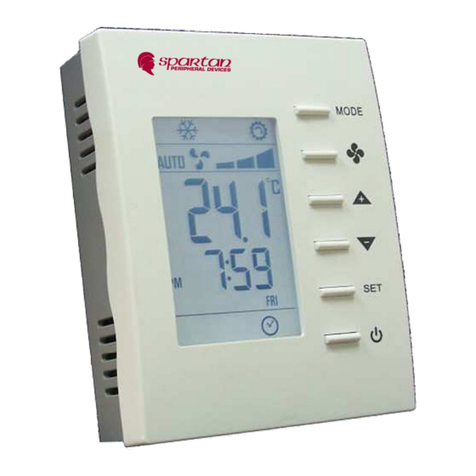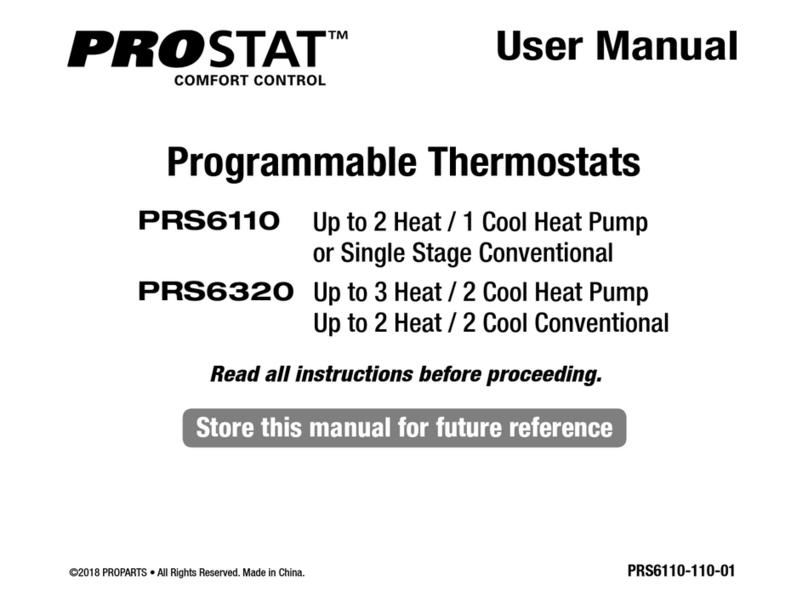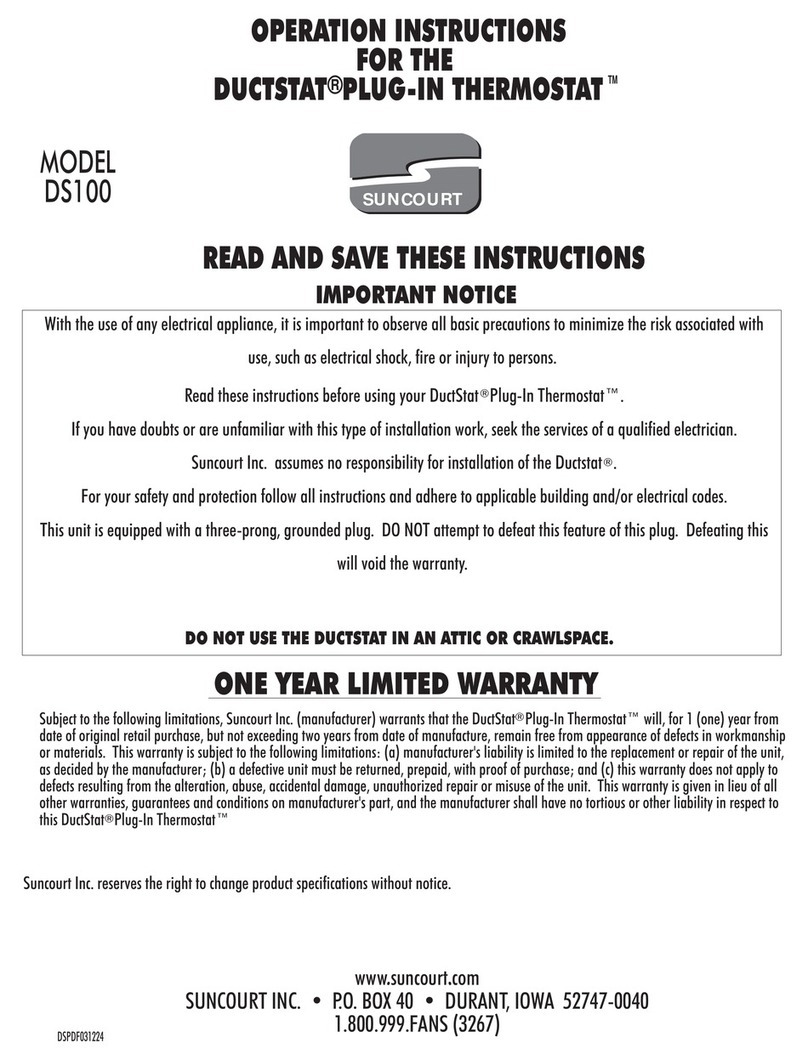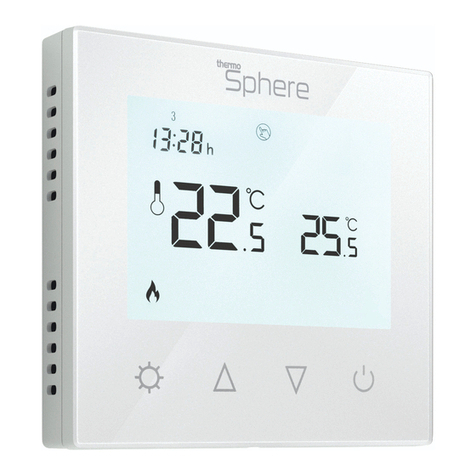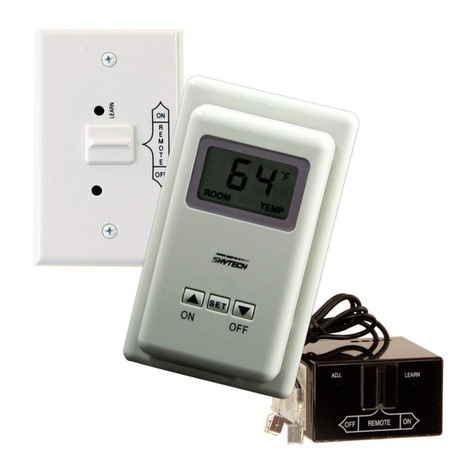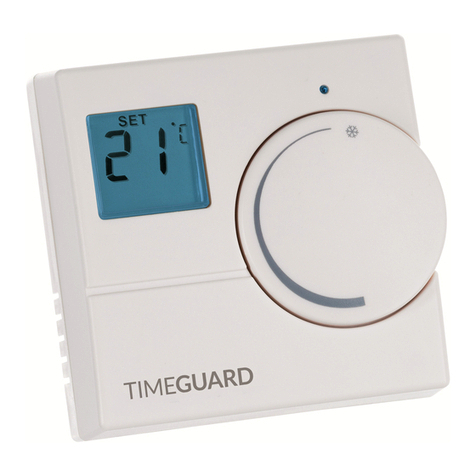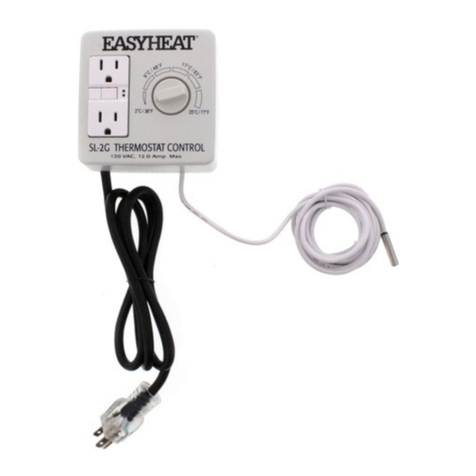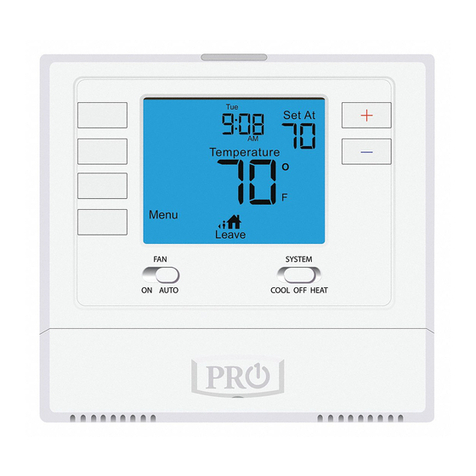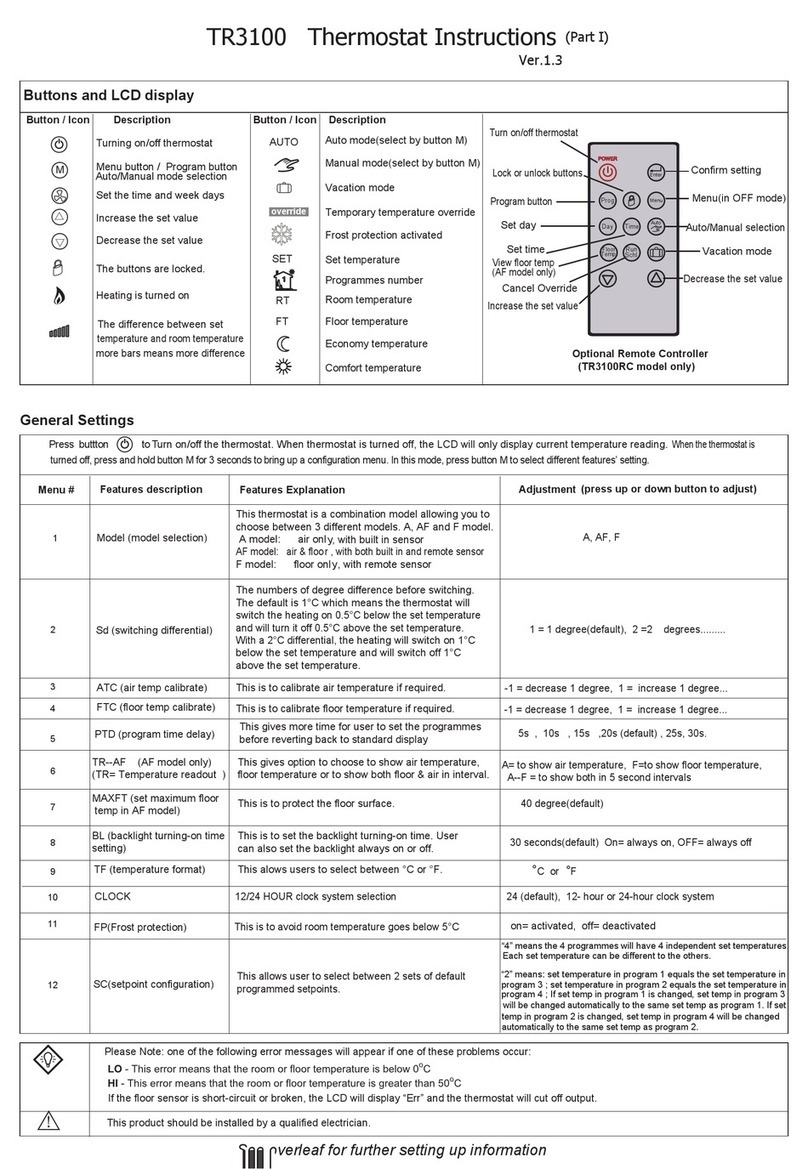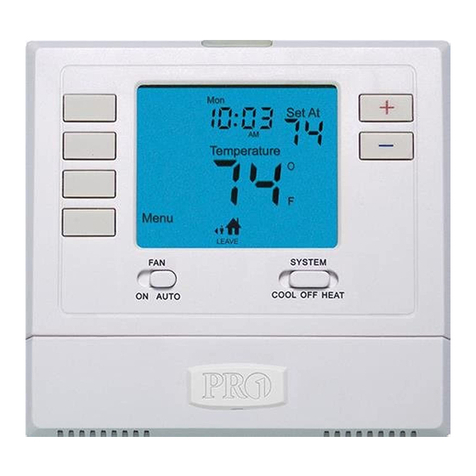Spartan TE221 Series User manual

Revised Date: 2017/08/24 1
TE221 Series
Programmable Digital Room Thermostats
Modulating or On/ Off Heating Control
OPERATION MANUAL
Front view Back view
# Item Description
1 LCD Display temperature and working status.
2 MODE button Access to user and engineer menu and for setting
confirmation
3 ℃/ ℉button Toggle to change ℃/ ℉ scale unit
4 UP & DOWN buttons Increase & decrease setting or previous/next item
5 SET button Setting for schedules and Time/ Date
6 On/Off button Start/ Stop Using Heating Device
7 Set-point icons Displaying set-point temperature while it is flashing
8 AUTO icons Device is in Using
9 Flake icon NA
10 Hot spring icon Indicate working on Heating mode
11 Flow icon NA
12 Gear icon Indicate Heating Device currently is Open or ON
13 Clock NA
14 Sleep NA
15 Moon Sign Indicating room is unoccupied via occupancy contact
16 Outdoor icon NA
17 Cover screw Screw to tighten back cover with front cover
18 Back plate Plate for mounting on electric box
19 Wiring terminal blocks Terminals for wiring
20 Mounting holes Holes for mounting on electric box
21 Time Display time
22 Schedule number Current Schedule running or setting
23 Day Current day of Sunday ~ Saturday or Selected setting
day
1151-5-1-01

Revised Date: 2017/08/24 2
Installation
Mounting on electric box
1. Separate back plate from the controller by loosing the cover screw;
2. Align the mounting holes on the screw holes of the electric box(applicable to 65x65 or US standard box);
3. Fix the back plate on the electric box by tightening the back plate screws. Suggest to use Philips wider “truss head” or
“washer head” #6-32x 3/4”(20mm).
4. DO NOT let the bolt head rise above the wall of mounting holes of back plate. It might cause the short circuit of the
controller.
Mounting front cover
1. Lock front cover on the back plate by tightening the cover screw underneath with screw driver of Philip electronic
instrument type or similar.
Wiring Example
1. All wires come from electric box must be inserted above the retainers of respective terminal block before
tightening the captive screws;
I/O
AO1(0~10VDC) DO1(SPDT Relay) RS ESI
Modulating Type
Heating Output On/ Off Type Heating
Output Remote Temperature
Sensor(NTC 10K) Occupancy Contact

Revised Date: 2017/08/24 3
Operation
User Mode Operation
The first tier of operation includes the following settings as Figure 2. To operate:
1. Power switch “ON” or “OFF” to start/ stop the System;
2. After switching “ON”, press any button to start the User Mode operation.
i. Press “MODE” button to switch over different program modes.
ii. Press UP/ DOWN button to increase/ decrease or rotate the values of setting.
iii. Press “℃/ ℉” button to toggle between ℉and ℃ scale.
iv. Press “SET” button to set current time-date. When SET is pressed for more than 3 seconds, users can
set the temperature setpoint schedules.
3. It will return to normal display with the latest setting if there’s no button pressed for 10 seconds.
# Item Description Remarks
1 Normal Display Display Current Room or Set-Point
Temperature and Current Time-Day. Setting “-SP- “Parameter in
Engineer Table to Choose Current
Room or Set-Point Temperature.
2 Temperature Setting View Current Set Point or Set the
Required Temperature
3 Mode Select 1. Select the Working Mode:
(1) Run/ Halt/ Stop for Schedule RUN: Run Schedules.
HALT: Pause “Current” Schedule
and Use Manual SP.
STOP: Stop Using All Schedules
and Use Manual SP.
4 ℃/ ℉1. It will toggle the Unit of Temperature
to change between ℉and ℃.
5 Time/ Date/ Schedule
Setting
SET
1. Set Current Time in 12- Or 24- Hour
Format;
2. Set Calendar and Day of Week;
3. When SET Is Pressed for More Than
3 Seconds, Users Can Set
Temperature Set Point Schedules
Press SET to Continue Settings.
Press MODE, Or POWER
Button to
Escape Any Time During Setting.

Revised Date: 2017/08/24 4
Fig. 2 User Mode operation sequence

Revised Date: 2017/08/24 5
Overview for the settings of Clock and Schedules
�Press ℃/ ℉or POWER button to escape any time during setting.

Revised Date: 2017/08/24 6
1. Detailed State Diagram for Clock Setting

Revised Date: 2017/08/24 7
2. Detailed State Diagram for Schedule Setting
Press “Mode” button to select
(day shows steadily)/ deselect
(day flash).
Press MODE button to
toggle Cooling/ Heating
Set points
Press MODE button to
toggle Cooling/ Heating
Set po
ints
Press MODE button to
toggle Cooling/ Heating
Set points

Revised Date: 2017/08/24 8
Default Set Point Schedules
COOL Sun Mon Tue Wed Thu Fri Sat
Sch. 1
6:00
26.0℃6:00
26.0℃6:00
26.0℃6:00
26.0℃6:00
26.0℃6:00
26.0℃6:00
26.0℃
Sch. 2
8:00
29.5℃8:00
29.5℃8:00
29.5℃8:00
29.5℃8:00
29.5℃8:00
29.5℃8:00
29.5℃
Sch. 3
18:00
26.0℃18:00
26.0℃18:00
26.0℃18:00
26.0℃18:00
26.0℃18:00
26.0℃18:00
26.0℃
Sch. 4
22:00
26.0℃22:00
26.0℃22:00
26.0℃22:00
26.0℃22:00
26.0℃22:00
26.0℃22:00
26.0℃
HEAT Sun Mon Tue Wed Thu Fri Sat
Sch. 1
6:00
21.0℃6:00
21.0℃6:00
21.0℃6:00
21.0℃6:00
21.0℃6:00
21.0℃6:00
21.0℃
Sch. 2
8:00
16.0℃8:00
16.0℃8:00
16.0℃8:00
16.0℃8:00
16.0℃8:00
16.0℃8:00
16.0℃
Sch. 3
18:00
21.0℃18:00
21.0℃18:00
21.0℃18:00
21.0℃18:00
21.0℃18:00
21.0℃18:00
21.0℃
Sch. 4
22:00
16.0℃22:00
16.0℃22:00
16.0℃22:00
16.0℃22:00
16.0℃22:00
16.0℃22:00
16.0℃
�Unoccupied Set Points: activated by occupancy contact; Cooling: 28.0℃/ Heating: 15.0℃
�When schedules are activated, refer to cooling/ heating set points according to current
schedule.
�When pause or stop schedules, refer to manual set point or latest set point as Cooling Set
Point and dead band for Heating Set Point deviation.
�Scheduled Cooling Set Point range: 10.0℃ ~ 37.0℃; Heating Set Point range: 4.5℃ ~ 32.0
℃; make sure to set heating lower than cooling set point to have proper controls.

Revised Date: 2017/08/24 9
Control Actions
There are two types of heating control output: Modulating (0~10 VDC) and On/ Off (SPDT
relay). Both will output simultaneously.
1. Modulating Type Heating Control:
(1) Output Voltage: Valve output allow minimum adjustment (AO1 Low(E5)) from 0-2 Vdc and maximum
adjustment (AO1 High(E6)) from 8 to 10 Vdc. These two output voltages can be gauged by multimeter during
setting to reflect the setting change effects.
(2) Reverse Output: The output voltage can be reversed by setting rE-H(E18) to 0(Direct) or 1(Reverse).
(2) When Demand for Heating, a “Running ( Gear) ( )” icon will be shown on the LCD.
Current
Temperature
10 VDC
Modulating Type Heating Output (Direct Output)
Proportional
Band
0 VDC
SP
Modulating Type Heating Output (Reverse
Output)

Revised Date: 2017/08/24 10
2. On/ Off Type Heating Control:
(1) Control Output: SPDT relay 24Vac output allows connecting to N.O. or N.C. terminal depending on
requirement. On Demand for Heat Terminal 3 will = 24Vac On/ Off differential can be set at (dIFF(E19)).
By pressing POWER button OFF you can switch the heating device OFF Terminal 3 = 0Vac Terminal 4 = 24Vac
Special:
1. ESI (Energy Saving Input) Contact status -- When the contact is activated (Room unoccupied), a “Moon ( )”
icon will be shown on the LCD and the thermostat will change the set-point temperatures of Cooling & Heating
to be ESIC & ESIH (refer to Engineer table for details.). When the contact is deactivated (Room back to be
occupied), it will set the set-point values back as normal.
2. If disable local ESI contact detection, the room will become always occupied status as default.
3. The icon , , , or will be shown on LCD while the Schedule 1,2,3, or 4 is running or being
set.
4. If press “MODE” button, there are three schedule modes “RUN, HALT, and STOP” for selection.
a.) RUN mode means activating Schedules. And at the same time an icon ( ~ ) will be steadily shown
on the LCD.
b.) HALT mode means temporarily pause current schedule and using manual S.P instead. And the icon
( ~ ) will be flashing on the LCD.
On
Current
Temperature
Heating
Stage
Differential
SP
OFF
On/ Off Type
Heating Output

Revised Date: 2017/08/24 11
c.) STOP mode means stop to use manual S.P until manually activate schedule again. And the icon
( ~ ) will be NOT shown on the LCD.

Revised Date: 2017/08/24 12
Engineer Mode Operation
This mode is highly suggested to be operated by trained engineers because it is related to system parameters that
will affect the control results. To operate:
1. Press “Up” and “Down” buttons for over 5 seconds to enter into engineer mode;
2. Press UP or DOWN button to rotate the menu item and press MODE button to enter into the item;
3. Press UP or DOWN button to change the setting and press MODE button to confirm the setting and return to
menu item selection. For no button pressed for 10 seconds, it will go back to menu item selection. The setting
won’t be changed then.
4. To leave Engineer Mode, rotate till “End” and press MODE button or leave the button intact for 10 seconds.
Engineer mode operation flow chart:
Fig. 3 Engineer Mode operation sequence
E01
E02
+
End
MODE
E01 Setting _
+
MODE
_
User Mode
+
_
+
MODE
E02 Setting
MODE
MODE
_
Previous
No button pressed
for 10s under menu
item selection
+
_
+
Press Up/down
for over 5s

Revised Date: 2017/08/24 13
Engineer mode menu item descriptions:
°C Type °F Type
Item Mnemonic Description Default Range Default Range
Step
E1 db Deadband 4.0 0~10.0 7.0 0~18.0 0.5 (°C/°F)
E2 ESIC Unoccupied(ESI) Cooling Set
Point 28.0 25.0~35.0 82.0 77.0~95.0
1.0 (°C/°F)
E3 ESIH Unoccupied(ESI) Heating Set
Point 15.0 10.0~22.0 59.0 50.0~72.0
1.0 (°C/°F)
E4 I-t Integral Time and Output Cycle
Time 90 10~500 90 10-500 10 (Sec.)
E5 AO1L Analog Output 1(Valve) Low
Adjustment 0 0~50 0 0~50 1(~0.04V)
E6 AO1H Analog Output 1(Valve) High
Adjustment -19 -50~0 -19 -50~0 1(~0.04V)
E7 AO2L Not Used
E8 AO2H Not Used
E9 SP-L Low Limit for Temperature Set
Point 10.0 0~50.0 50.0 32.0~122.0
1.0 (°C/°F)
E10 SP-H High Limit for Temperature Set
Point 35.0 0~50.0 95.0 32.0~122.0
1.0 (°C/°F)
E11 OFSt Current Temperature Offset 0.0 -10.0~10.0
0.0 -18.0~18.0
0.1 (°C/°F)
E12 Pb Proportional Band or Stage
Width 2.0 0~10.0 3.6 0~18.0 0.1 (°C/°F)
E13 LOC
Bit Definition ---
Bit 0: Mode Button
1: Down Buttons
2: Up Button
3: °C/°F Button
4: Power Button
5: Set Button
6: ESI Contact Detection
7: Door/Window Contact
ct detection
*Bit Value
0: Unlock / enable
1: Lock / disable
Examples:
0- Unlock/enable all
1- Lock MODE
Button
2- Lock Down Button
…
8-Lock °C/°F Button
…
15-Lock MODE & Down & Up &
°C/°F Buttons
16-Lock Power Button
…
64-Disable ESI contact detection
…
128-Disable Door/Window
contact detection
…
255- Lock/disable all
0 0-255 0 0-255 1

Revised Date: 2017/08/24 14
E14 ESI ESI Contact Definition 0 0~1 0 0~1 0: N.O.
1: N.C.
E15 rS
Present Temperature Is Getting
from Built-In Temperature
Sensor, or Remote Temperature
Sensor.
0 0~1 0 0~1 0: built-in
1: remote
E16 -SP- Display Present Value of
Temperature or Set-Point for
Normal Displaying 0 0-1 0 0-1
0: display PV
1: display SP
E17 rE-C Not Used
E18 rE-H Modulatin
g Heating direct/
reverse signal output 0 0-1 0 0-1 0 (direct)
1 (reverse)
E19 diFF Stage differential 0.5 0.1~1.0 0.9 0.1~1.8 0.1 (°C/°F)
E20 tESt Self-Diagnostic
E21 rSt Reset All Parameters to Factory
Defaults
E22 End Exit Engineer Mode
Table of contents
Other Spartan Thermostat manuals
Popular Thermostat manuals by other brands

HeatLink
HeatLink 46544 user guide
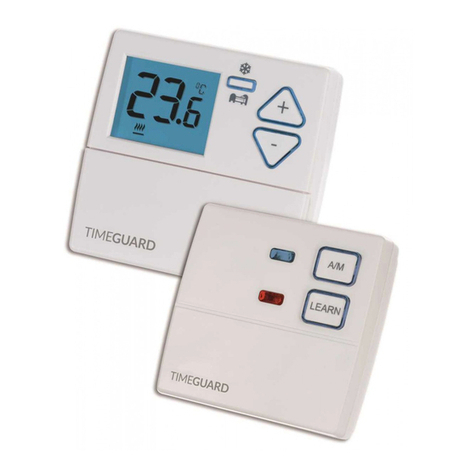
Timeguard
Timeguard TRT047N Installation & operating instructions
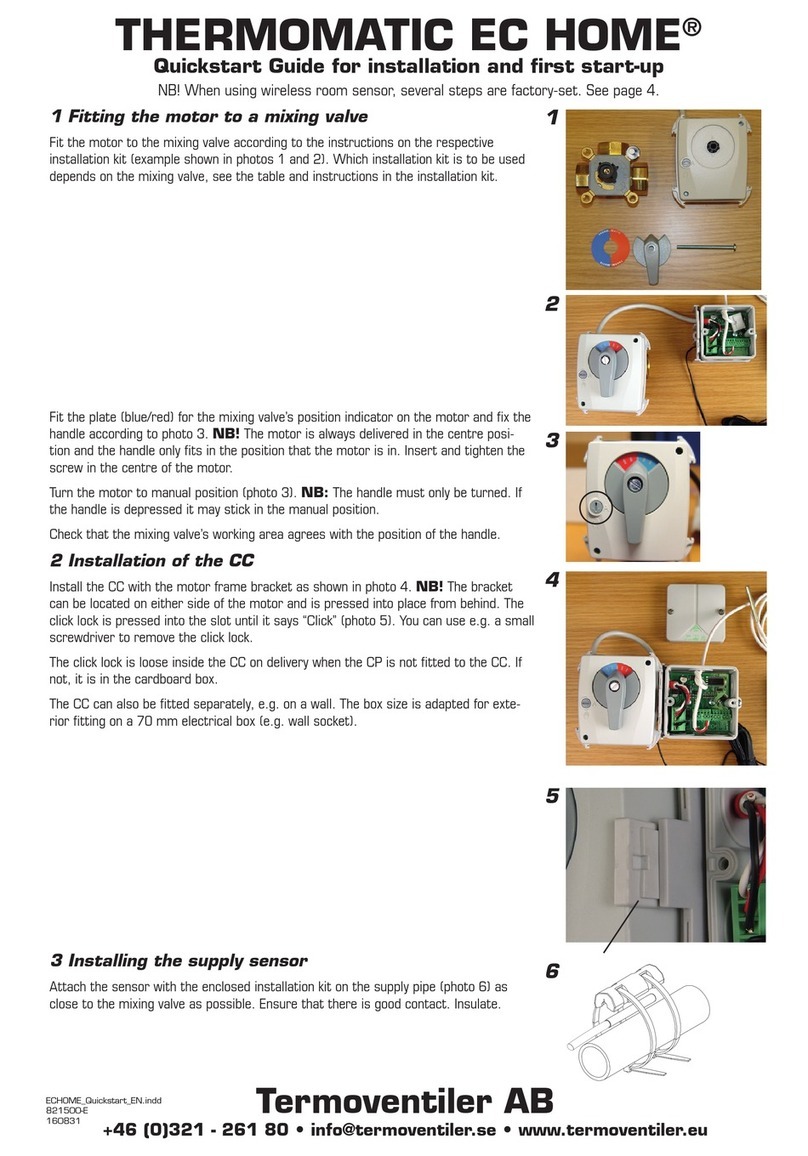
Termoventiler
Termoventiler Thermomatic EC Home Quickstart Guide for installation and first start-up

Mark
Mark PINTHERM INFRA II Technical manual
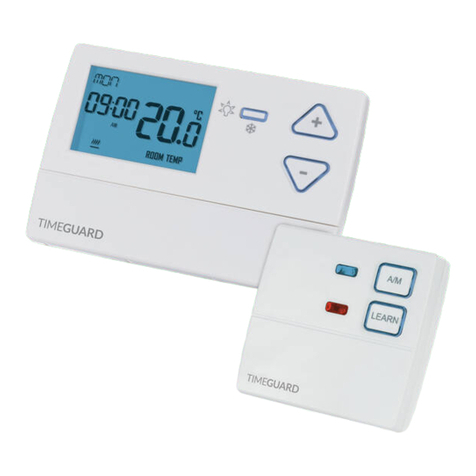
Timeguard
Timeguard TRT037N Installation & operating instructions

Fantini Cosmi
Fantini Cosmi CH150 manual
